
 The Game: You’ve got a mobile paddle and – well, frankly, balls. But you don’t have a lot of balls at your disposal (am I the only one becoming a little bit uncomfortable discussing this?), so you have to make the best use of them that you can to knock down the rows of colorful bricks overhead. Missing one of your precious balls – and we all know how painful that can be – forces you to call another ball into play. Losing all of your balls, as you’ve probably guessed by now, ends the game. So, in essence, Breakout is a metaphor for life from the masculine perspective. (Atari, 1976)
The Game: You’ve got a mobile paddle and – well, frankly, balls. But you don’t have a lot of balls at your disposal (am I the only one becoming a little bit uncomfortable discussing this?), so you have to make the best use of them that you can to knock down the rows of colorful bricks overhead. Missing one of your precious balls – and we all know how painful that can be – forces you to call another ball into play. Losing all of your balls, as you’ve probably guessed by now, ends the game. So, in essence, Breakout is a metaphor for life from the masculine perspective. (Atari, 1976)
Memories: The year was 1976, and Atari’s founder, Nolan Bushnell, had an idea to revive the overmined “ball and paddle” genre: turn Pong into a single-player game, almost like racquetball, in which players must smash their way through a wall of bricks with a ball without missing that ball on the rebound. Bushnell was sure the idea would be a hit. [read more]

 The Game: Avoid missing ball for high score.
The Game: Avoid missing ball for high score.

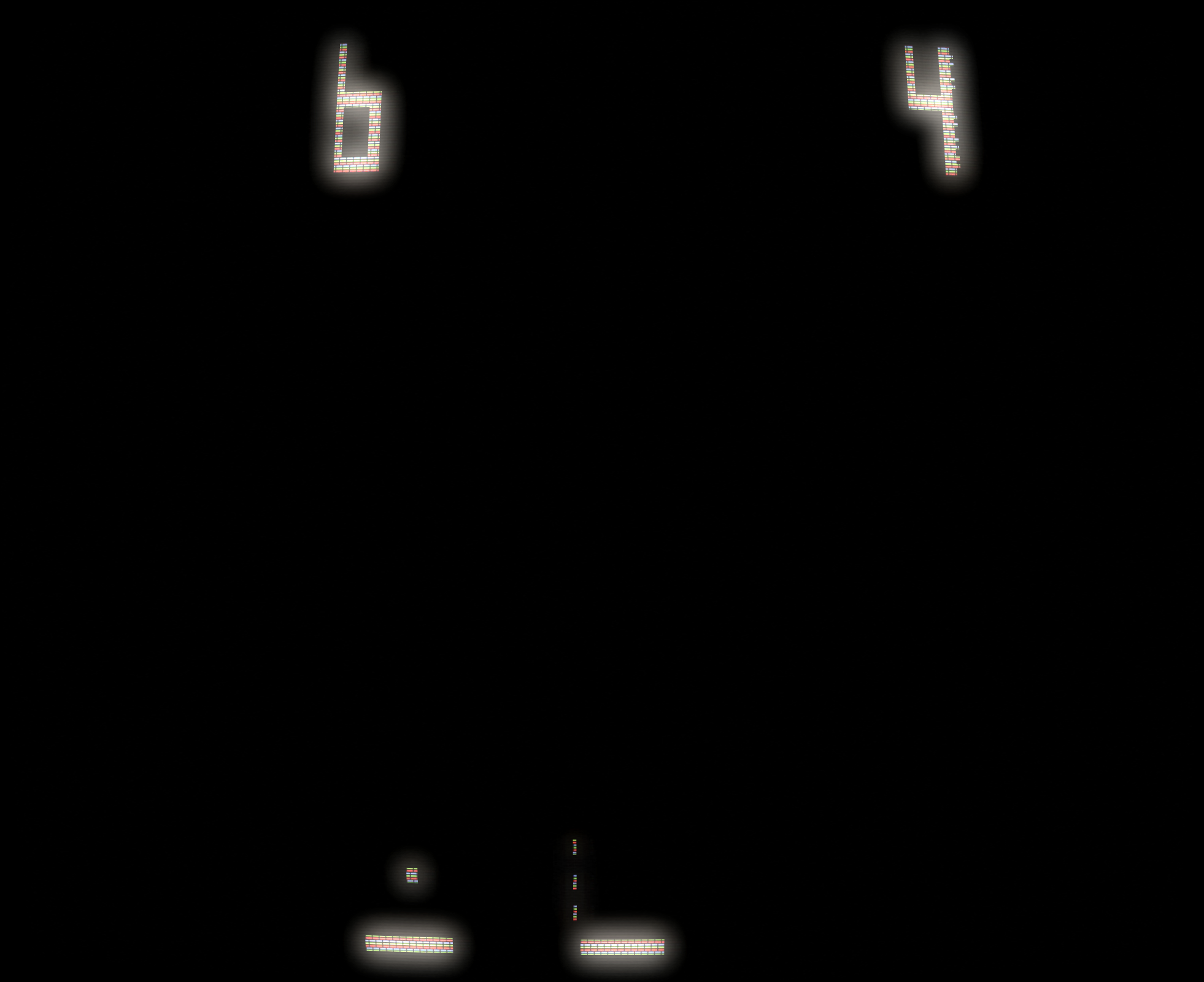
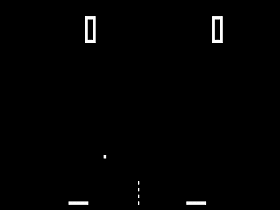 The Game: Live in glorious black & white, it’s the first-ever game of video volleyball! Two players square off – well, okay, rectangle off – against each other as horizontal Pong paddles situated on either side of a dotted-line “net.” The ball drops out of mid-air toward one player or the other, who must move into place to (hopefully) bounce the ball into the right direction. It may take a couple of tries to get the ball over the net, but don’t let it take three bounces or you forfeit a turn (and a point). (Atari, 1973)
The Game: Live in glorious black & white, it’s the first-ever game of video volleyball! Two players square off – well, okay, rectangle off – against each other as horizontal Pong paddles situated on either side of a dotted-line “net.” The ball drops out of mid-air toward one player or the other, who must move into place to (hopefully) bounce the ball into the right direction. It may take a couple of tries to get the ball over the net, but don’t let it take three bounces or you forfeit a turn (and a point). (Atari, 1973)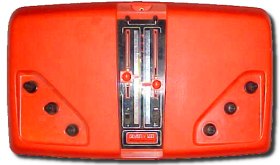 The Game: A simple version of video ping-pong; players use three knobs, one to control horizontal movement, one to control vertical movement, and a third to control the “English” or spin of the ball. (Magnavox, 1975)
The Game: A simple version of video ping-pong; players use three knobs, one to control horizontal movement, one to control vertical movement, and a third to control the “English” or spin of the ball. (Magnavox, 1975)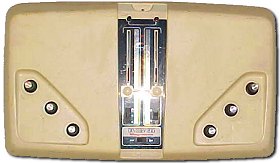 Talk about upscale. The Odyssey 200, released not long after the
Talk about upscale. The Odyssey 200, released not long after the 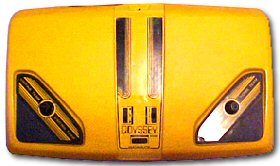 Taking Atari’s lead for the first time, the Odyssey 300 – in its bright yellow shell – saw the console abandoning the trio of horizontal/vertical/English controls that had been in place since the original Odyssey. In addition to mimicking the all-in-one controls of Atari’s Pong, Odyssey 300 – still boasting the standard Tennis, Hockey and Smash variations of its predecessors – introduced digital on-screen scoring. The Odyssey games were no longer reliant on the honor system: at 15 points, one player won the game. [read more]
Taking Atari’s lead for the first time, the Odyssey 300 – in its bright yellow shell – saw the console abandoning the trio of horizontal/vertical/English controls that had been in place since the original Odyssey. In addition to mimicking the all-in-one controls of Atari’s Pong, Odyssey 300 – still boasting the standard Tennis, Hockey and Smash variations of its predecessors – introduced digital on-screen scoring. The Odyssey games were no longer reliant on the honor system: at 15 points, one player won the game. [read more]
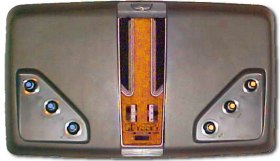 With the same trio of games as the Odyssey 400 – Tennis, Hockey/Soccer and Smash – the Odyssey 500, released in 1976 by Magnavox, would appear to not be much of an upgrade, but in fact, it’s an absolutely critical turning point for home video games: the Odyssey 500 did away with squares and rectangles to represent the player, and introduced character sprites – hardware-generated characters that roughly mimicked the shape of a human being. [read more]
With the same trio of games as the Odyssey 400 – Tennis, Hockey/Soccer and Smash – the Odyssey 500, released in 1976 by Magnavox, would appear to not be much of an upgrade, but in fact, it’s an absolutely critical turning point for home video games: the Odyssey 500 did away with squares and rectangles to represent the player, and introduced character sprites – hardware-generated characters that roughly mimicked the shape of a human being. [read more] The Game: Activated by leaving a cartridge out of the slot, powering the system up and pressing one of the selector keys, Tennis and Hockey are built into the system. Timed games can be selected, and the traditional rules of each sport apply. (Fairchild, 1976)
The Game: Activated by leaving a cartridge out of the slot, powering the system up and pressing one of the selector keys, Tennis and Hockey are built into the system. Timed games can be selected, and the traditional rules of each sport apply. (Fairchild, 1976)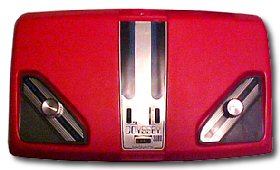 After the baffling backward step of the Odyssey 400, Magnavox’s Odyssey 2000 saw a return to the Pong-inspired, single-paddle control scheme, with digital scoring restored as well – Magnavox had decided to rest the Brown Box design (and the subsequent variations on it) permanently in favor of, once again, the General Instruments AY-3-8500 “Pong on a chip” processor. Packaged in a red casing, this would be the last anyone would see of the smoothly rounded-off, integrated Odyssey console. The next system to bear the name would return to its roots – with wired controllers that weren’t necessarily stuck to the main console – and look forward, with a futuristic new design that stands up even today. [read more]
After the baffling backward step of the Odyssey 400, Magnavox’s Odyssey 2000 saw a return to the Pong-inspired, single-paddle control scheme, with digital scoring restored as well – Magnavox had decided to rest the Brown Box design (and the subsequent variations on it) permanently in favor of, once again, the General Instruments AY-3-8500 “Pong on a chip” processor. Packaged in a red casing, this would be the last anyone would see of the smoothly rounded-off, integrated Odyssey console. The next system to bear the name would return to its roots – with wired controllers that weren’t necessarily stuck to the main console – and look forward, with a futuristic new design that stands up even today. [read more]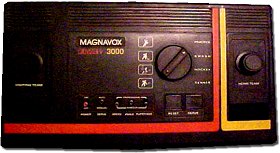 It adds nothing to the Odyssey 2000’s “four action-packed video games,” but the Odyssey 3000 is a quantum leap in the design aesthetic of the console itself. Finally breaking away from the basic casing design that had been in place since the Odyssey 100, Odyssey 3000 packs four games (well, really just three plus a Tennis “practice mode”) into a sleek, futuristic-looking black wedge with highlights that almost anticipate – believe it or not – the look of the computer screens in Star Trek: The Next Generation (though to be more realistic, it may have been influenced by the design line of Atari’s Fuji logo). The controllers are detachable but hardwired, and nestle snugly into the console itself. [read more]
It adds nothing to the Odyssey 2000’s “four action-packed video games,” but the Odyssey 3000 is a quantum leap in the design aesthetic of the console itself. Finally breaking away from the basic casing design that had been in place since the Odyssey 100, Odyssey 3000 packs four games (well, really just three plus a Tennis “practice mode”) into a sleek, futuristic-looking black wedge with highlights that almost anticipate – believe it or not – the look of the computer screens in Star Trek: The Next Generation (though to be more realistic, it may have been influenced by the design line of Atari’s Fuji logo). The controllers are detachable but hardwired, and nestle snugly into the console itself. [read more]